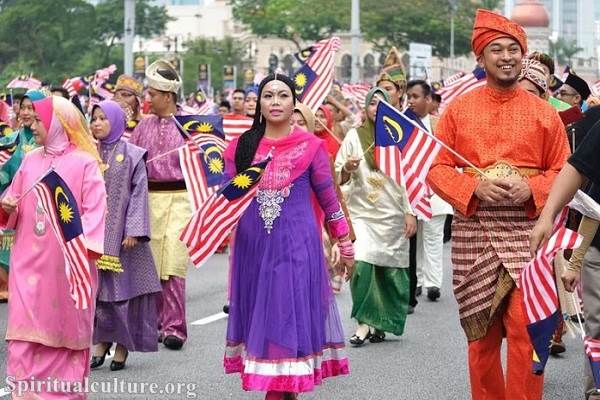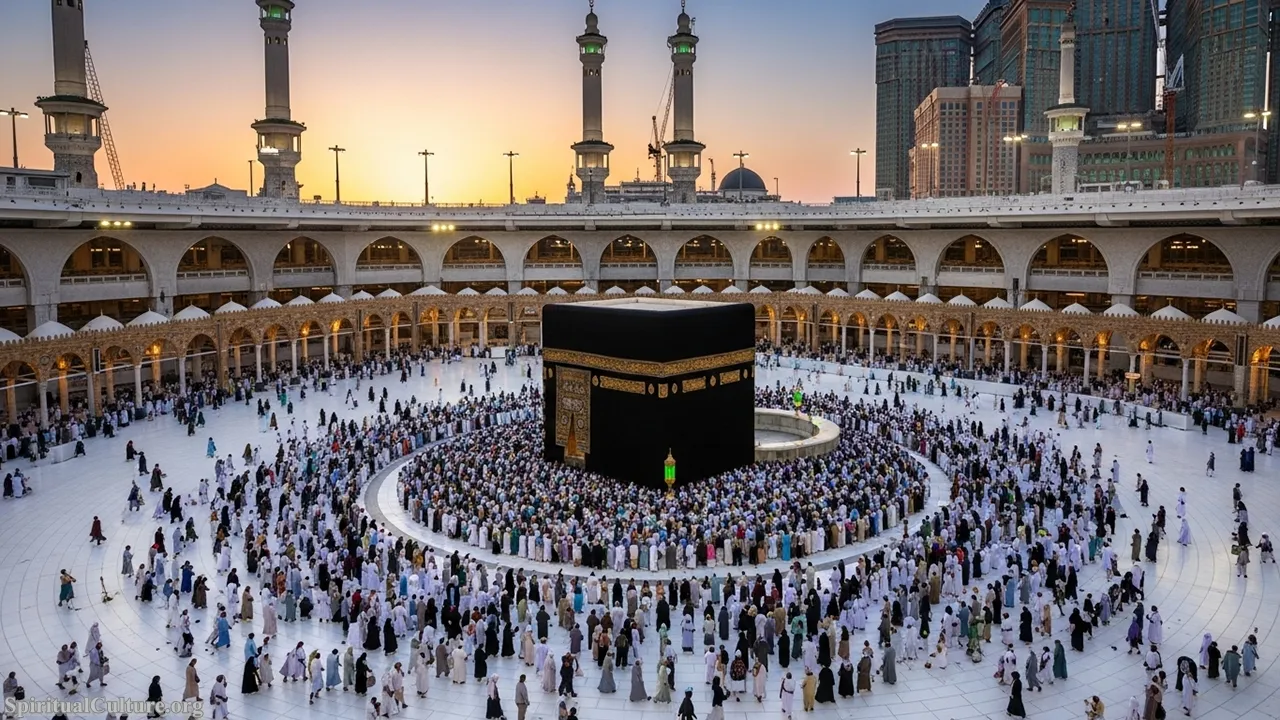The cultural landscape of the United States is a dynamic tapestry woven from the threads of immigration, indigenous history, and evolving social values. As of the Current Time of Writing in November 2025, the nation continues to be defined by core values such as individualism, democracy, and the pursuit of happiness. However, it is the shared traditions—especially those rooted in communal celebration and historical reflection—that provide the profound, collective spiritual pulse of the country.
At Spiritual Culture, we analyze these traditions not just by their widespread popularity but by their enduring cultural depth, their capacity to instill core American values, and their function as a collective ritual. This Top 10 list focuses on practices that transcend regional and religious divides to unite the greatest number of Americans in a common, reflective experience, grounding their popularity in historical data and sociological impact.
From national holidays that commemorate the struggle for independence and unity, to daily practices that define social interaction, these traditions serve as the spiritual anchor for millions, connecting the contemporary American experience to its foundational heritage. Each entry is a testament to the power of shared culture in shaping a national identity.
Table of the Top 10 American Traditions with the Greatest Cultural and Spiritual Reach
| Rank | Tradition | Core Spiritual/Cultural Value | Estimated Prevalence/Impact (as of Nov 2025) |
|---|---|---|---|
| 1 | Thanksgiving Feast & Gratitude | Gratitude, Family Unity, Harvest Blessing | Observed by over 88% of American households; a central non-denominational spiritual holiday. |
| 2 | Independence Day (Fourth of July) Celebrations | Freedom, National Pride, Democracy, Self-Governance | Widespread civic ritual; over 90% of cities hold fireworks/parades/events. |
| 3 | Christmas Season/Gift Giving | Generosity, Hope, Renewal, Family Love | Celebrated by over 90% of Americans (secular or religious); the largest gift-giving tradition. |
| 4 | The American Dream (Ethos of Hard Work) | Meritocracy, Individualism, Self-Reliance, Hope | A foundational, secular belief system permeating education and career culture. |
| 5 | Halloween: Trick-or-Treating & Costumes | Community Bonding, Imagination, Cultural Play, Liminality | Observed by two-thirds of Americans; the second-largest decorating holiday after Christmas. |
| 6 | Sporting Events and Tailgating | Communal Identity, Loyalty, Regional Pride | A core social ritual, especially surrounding American football (NFL/College) and baseball. |
| 7 | Memorial Day/Veterans Day Observance | Remembrance, Sacrifice, Civic Duty, Collective Honor | Federal holidays providing solemn national reflection on service and loss. |
| 8 | The Barbecue/Cookout Culture | Informality, Hospitality, Backyard Community, Summer Ritual | A ubiquitous cultural staple for social gathering across all regions and classes. |
| 9 | The Right to “Pursuit of Happiness” | Personal Fulfillment, Individual Liberty, Optimism | A philosophical tradition enshrined in the Declaration of Independence that shapes lifestyle choices. |
| 10 | High School/College Sports Culture | Local Identity, Academic-Athletic Ideal, Community Rites of Passage | Unique to the U.S.; ties academic institutions to deep community bonding and loyalty. |
Top 10. The High School/College Sports Culture
The intense devotion to high school and college athletics is a cultural phenomenon unique to the United States. Far beyond simple spectator sport, this tradition is a profound rite of passage, creating a shared local history that binds communities together. As of November 2025, the loyalty to a university’s team often runs deeper than professional allegiances, providing a spiritual connection to one’s educational roots and reinforcing the value of dedication, teamwork, and local pride from a young age.
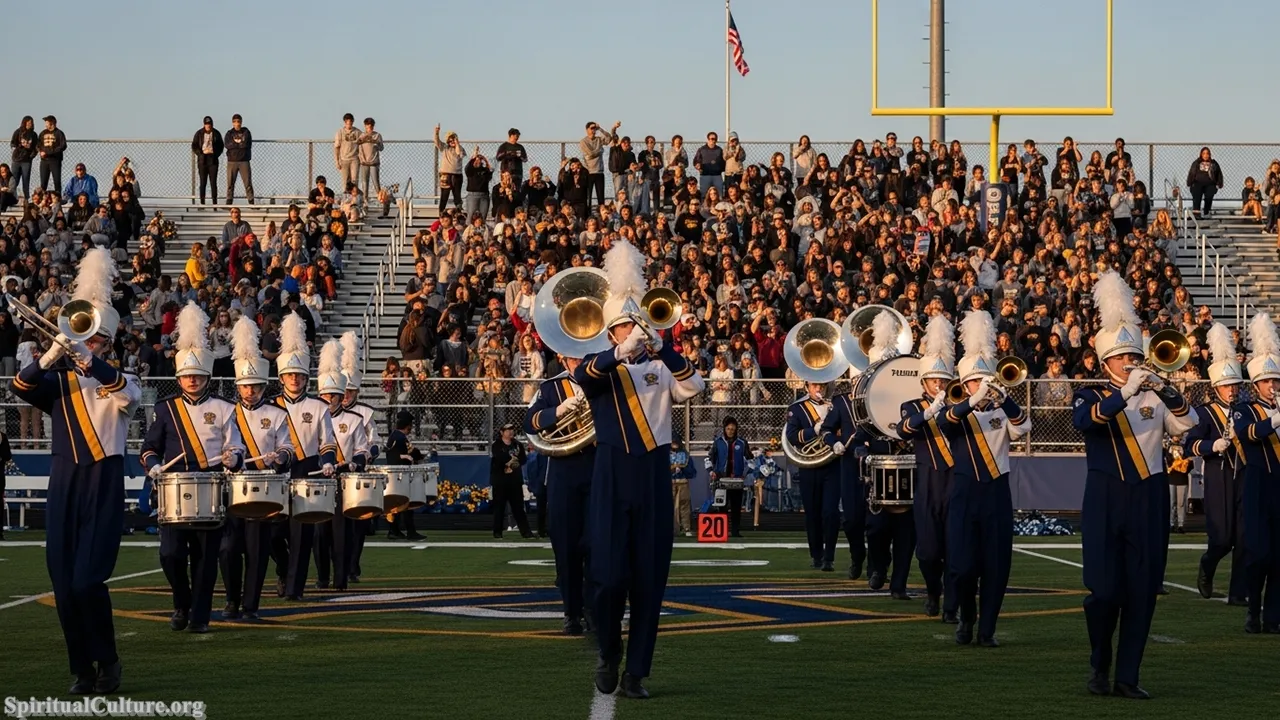
This deep-seated culture functions spiritually as a generator of intense collective effervescence. The shared anticipation of “game day,” the singing of fight songs, and the communal experience of cheering create a temporary, powerful unity among diverse individuals. The tradition teaches the moral lesson of perseverance—that success is earned through disciplined effort, linking athletic pursuit to the broader American ethos of striving for excellence.
The spiritual value here is in the creation of identity. Attending games, wearing school colors, and maintaining fierce but friendly rivalries are ways Americans ritualistically affirm their place within a specific community. It is a vital social structure that preserves the humanistic ideal of local belonging in an increasingly globalized world, underscoring the spiritual importance of loyalty and shared memory.
Cultural/Spiritual Highlights
- The “Fight Song” acts as a secular hymn, rallying collective identity and pride.
- Generates intergenerational bonding through shared campus memories and team history.
- Reinforces the American value of meritocracy: the best athletes earn recognition and opportunity.
- “School spirit” serves as a powerful, localized form of collective spiritual energy.
Top 9. The Right to “Pursuit of Happiness”
The philosophical tradition of the “pursuit of happiness,” enshrined in the Declaration of Independence, is a central, almost spiritual tenet of the American identity. It is not merely a legal right but a deeply ingrained cultural value that suggests an optimistic, active orientation toward life. This tradition, as it stands in November 2025, underpins a significant part of the American lifestyle, motivating everything from entrepreneurial endeavors to personal wellness trends, framing personal fulfillment as a virtuous, attainable goal.

The spiritual impact of this tradition is in its empowerment of the individual conscience. By placing the onus and the right for happiness directly on the person, it encourages self-discovery, resilience, and personal goal-setting. It teaches the moral lesson that life is not predetermined but is a matter of agency and choice—a fundamentally hopeful and liberating spiritual perspective that has drawn countless immigrants to the nation seeking a better life.
This tradition requires continuous re-evaluation in a diverse society, prompting a national conversation about what “happiness” truly entails—whether it is material wealth or internal peace. It represents a living preservation value, as Americans continuously debate and redefine their collective social contract based on the fundamental promise of personal fulfillment for all citizens.
Cultural/Spiritual Highlights
- A foundational principle from the 1776 Declaration of Independence, shaping national consciousness.
- Promotes the spiritual value of individual agency, choice, and optimism.
- Intertwined with the concept of the “American Dream,” suggesting opportunity for all.
- Its interpretation drives social progress, as marginalized groups fight for the equal right to pursue their own fulfillment.
Top 8. The Barbecue/Cookout Culture
The ubiquitous American tradition of the backyard barbecue or casual cookout is a cultural ritual of informality and hospitality that cuts across demographic lines. From Memorial Day through Labor Day, and even year-round in warmer climates, the act of grilling outdoors serves as a spiritual anchor for social bonding. As of November 2025, this tradition remains one of the most reliable and simple ways for Americans to gather, break bread, and build community, requiring little planning beyond a grill and good company.

The reason for its high ranking is its sheer democratic reach and profound spiritual simplicity. The cookout is an egalitarian space—an open backyard where neighbors, friends, and family are welcomed without the formalities of indoor entertaining. It is a celebration of abundance, sunshine, and simple pleasures, embodying a spiritual ethos of casual sharing and relaxed fellowship that contrasts with the fast pace of modern life. The smoke and the sizzle are almost a sensory ritual that signals a time to pause and connect.
The moral lesson embedded in this tradition is the value of open-heartedness and communal support. In a society often criticized for its isolation, the barbecue reinforces the essential humanistic value of being a good neighbor and a generous host. Preserving this tradition means preserving a key mechanism for face-to-face community interaction, which is a vital component of spiritual health.
Cultural/Spiritual Highlights
- Embodies the American value of informality, hospitality, and easy fellowship.
- Acts as a primary social ritual during the summer months and national holidays.
- The act of grilling and sharing food symbolizes bounty and relaxed communal joy.
- Universally practiced across all economic and regional demographics in the U.S.
Top 7. Memorial Day/Veterans Day Observance
These two federal holidays anchor a collective spiritual tradition of remembrance and honor for military service. While distinct in focus—Memorial Day (the last Monday in May) honors the fallen, and Veterans Day (November 11) honors all living and deceased veterans—both serve as mandated national moments for reflection and civic reverence. In November 2025, this tradition is maintained through the decoration of graves with flags, national parades, and organized moments of silence, unifying the country in shared solemnity and gratitude.
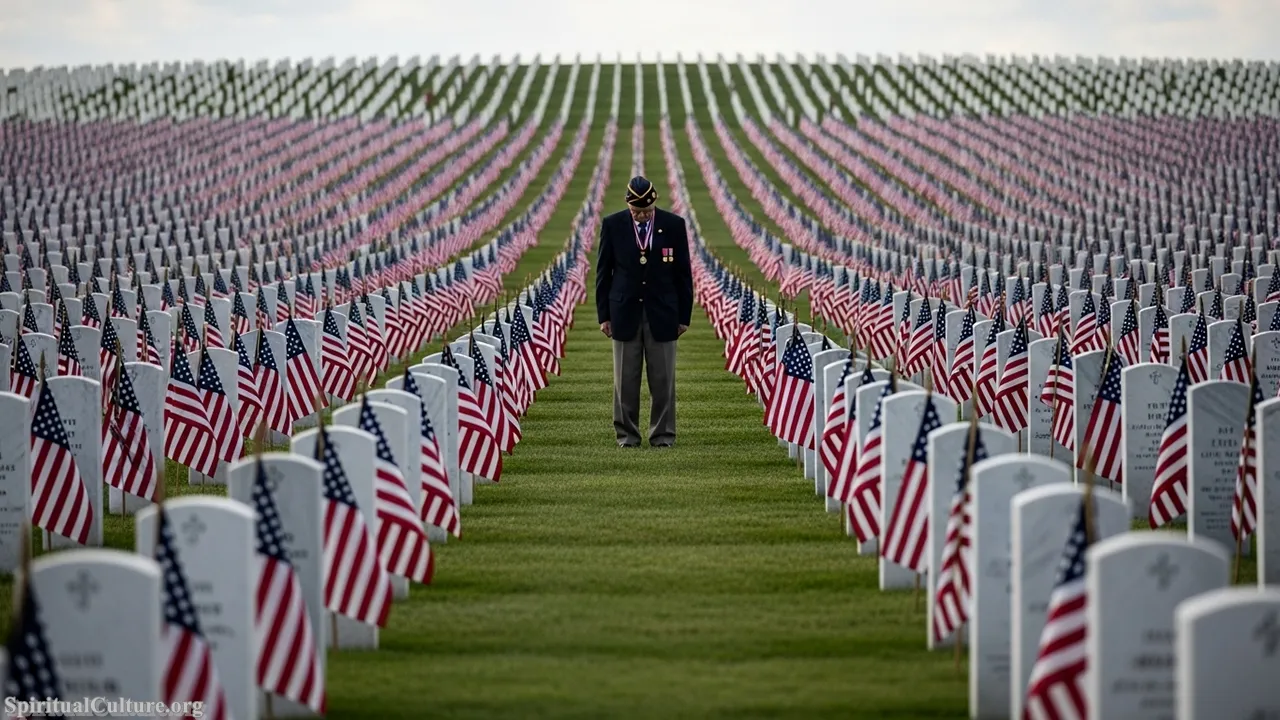
Their spiritual impact lies in their ability to draw the national gaze toward the abstract ideal of self-sacrifice. These observances are vital civic rituals that inject a profound sense of gravity into the national calendar, reminding citizens of the cost of freedom and the importance of duty. They teach the moral lesson that the nation’s security and freedoms are maintained by the dedication of its service members, fostering a collective humility and respect that transcends political divides.
The preservation value of these traditions is immense, as they ensure that the national memory of past conflicts and contributions remains vivid. They are a powerful, non-denominational spiritual exercise in collective grief and honor, encouraging citizens to reflect on their own civic responsibilities and the sacrifices made to uphold the core values of the Republic.
Cultural/Spiritual Highlights
- Instills the core civic value of sacrifice, duty, and collective honor.
- Memorial Day often involves a moment of silence at 3:00 PM local time for solemn reflection.
- Veterans Day honors all service, teaching gratitude for sustained civic dedication.
- The widespread display of the American flag acts as a visual, spiritual affirmation of national unity.
Top 6. Sporting Events and Tailgating
The ritualistic gathering known as “tailgating” before a major sporting event—particularly American football and baseball—is a deeply entrenched social tradition. It involves friends and strangers convening in parking lots hours before a game to share food, drinks, and collective anticipation. As of November 2025, this practice has grown into a major cultural fixture, transforming a parking lot into a temporary, vibrant community where social barriers are temporarily dissolved in a sea of team colors.
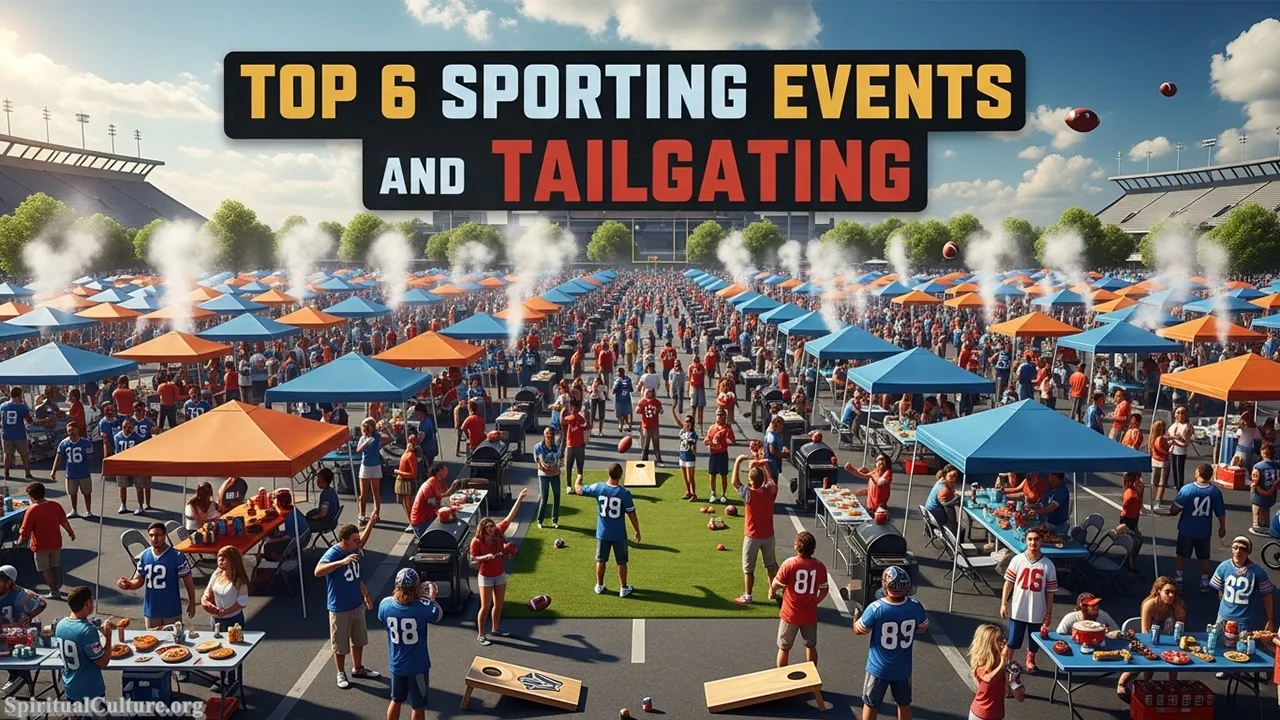
This tradition is ranked highly for its demonstration of ritualistic community formation. The tailgating gathering acts as a modern pilgrimage, where fans physically gather and engage in preparatory rituals (grilling, flag-raising, chanting) that elevate the upcoming game to a sacred, communal contest. The spiritual meaning lies in the powerful sense of belonging and the shared, passionate identification with a local or regional team, satisfying a profound human need for tribal affiliation and shared purpose.
The preservation of this tradition lies in its ability to foster social cohesion in an often-divided society. It teaches the moral lesson of shared identity and mutual respect among temporary “tribes.” Regardless of background, everyone is united by the common passion for the game and the willingness to share their resources, turning a mundane parking area into a space of spontaneous, joyful fellowship.
Cultural/Spiritual Highlights
- Tailgating is a secular pilgrimage, transforming a parking lot into a temporary spiritual center.
- Fosters a powerful sense of “tribal” community and regional collective identity.
- The shared food and drink ritual symbolizes abundance and open-handed generosity.
- Reinforces the cultural value of loyalty to local and regional institutions.
Top 5. Halloween: Trick-or-Treating & Costumes
The uniquely American adaptation of Halloween, centered on neighborhood trick-or-treating and widespread decoration, is a highly popular tradition that injects an element of playful liminality and community engagement into the fall season. As of November 2025, this has become the second-largest decorating holiday in the U.S. and a massive cultural phenomenon, transcending its ancient Celtic and Christian roots (Samhain, All Hallows’ Eve) to become a secular night of fantasy and neighborly interaction.
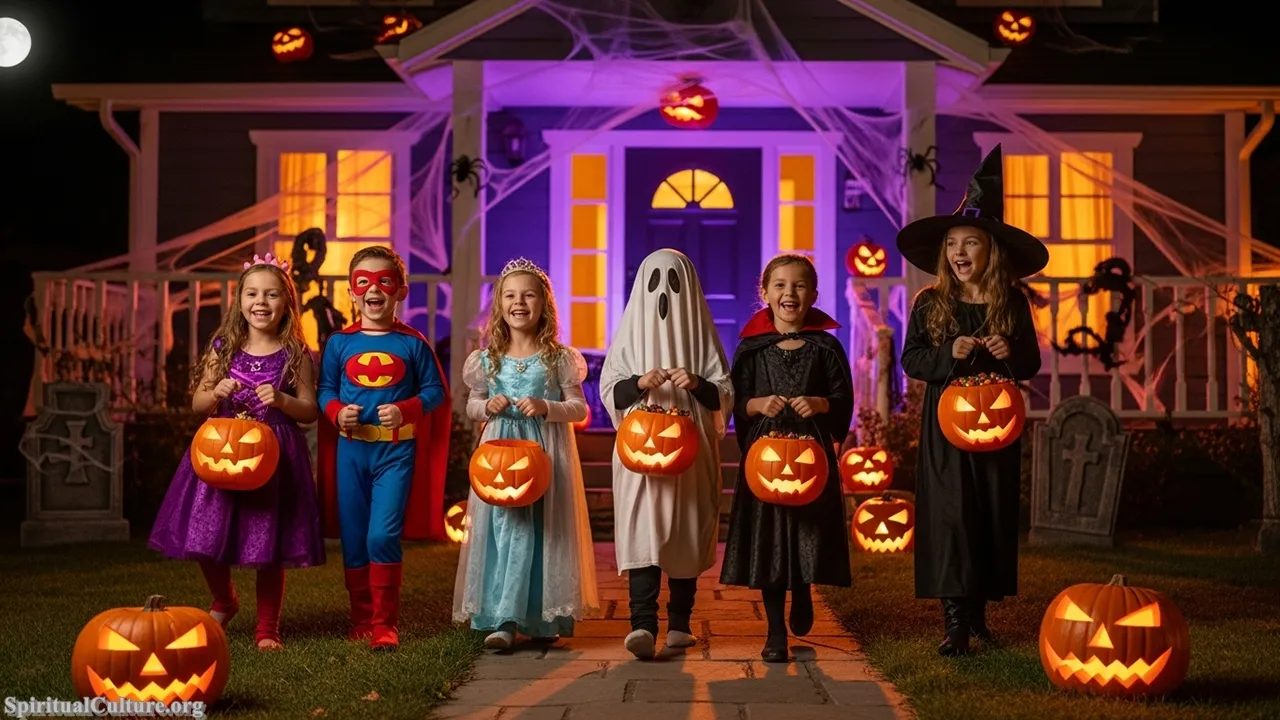
The spiritual value of this tradition is rooted in the safe exploration of the mysterious and the macabre. By donning costumes, individuals temporarily shed their everyday roles, encouraging imagination and cultural play. For children, trick-or-treating is a communal ritual of bounty and trust, where neighbors willingly dispense gifts. This practice teaches the moral lesson of reciprocal generosity and the importance of allowing space for structured, collective fantasy.
The tradition’s preservation value is found in its consistent ability to build community infrastructure. Halloween is one of the few contemporary traditions that requires direct, door-to-door interaction between neighbors, fostering a sense of localized spiritual awareness and safety. It ensures that, at least for one night, the street is a shared, welcoming space.
Cultural/Spiritual Highlights
- The wearing of costumes allows for a temporary, freeing spiritual release from everyday identity.
- Trick-or-treating is a communal ritual of gift exchange and neighborhood trust.
- The carving of the “Jack-o’-Lantern” is a widespread, creative artistic-spiritual practice.
- Links contemporary culture to ancient traditions dealing with the transition between seasons and worlds.
Top 4. The American Dream (Ethos of Hard Work)
The “American Dream” is less a celebration and more a foundational secular belief system—an enduring promise that, regardless of one’s background, hard work, sacrifice, and determination can lead to success and upward mobility. While often critiqued in November 2025 for societal inequalities, the fundamental ethos of individual striving remains a dominant cultural narrative, taught from schools to corporate boardrooms, serving as a powerful, non-denominational spiritual engine for the nation.

This tradition earns its rank because of its profound influence on daily behavior and morality. It functions as the ultimate spiritual imperative for the individualist society, encouraging people to take calculated risks, invest in education, and maintain an optimistic outlook on the future. The core moral lesson it teaches is that success is the rightful reward for sincere effort, providing a narrative framework for understanding one’s personal journey and justifying personal sacrifice.
The preservation of this ethos is crucial to the American narrative. It is a shared story of hope and renewal, suggesting that failure is not final and reinvention is always possible. This hopeful perspective forms the spiritual basis for much of the nation’s innovation and resilience, reinforcing the humanistic value of aspiration and meritocracy.
Cultural/Spiritual Highlights
- A foundational secular mythology centered on self-reliance and opportunity.
- Deeply rooted in the Protestant work ethic and 19th-century immigration narratives.
- Teaches the spiritual value that one’s destiny is shaped by one’s effort and character.
- Continues to serve as a powerful attractor for global immigration and new beginnings.
Top 3. Christmas Season/Gift Giving
Christmas in the United States, celebrated by over 90% of the population in some form (secular or religious), is the nation’s dominant winter spiritual and cultural ritual. While its Christian roots celebrate the birth of Jesus, the tradition, as observed in November 2025, has evolved into a massive cultural spectacle centered on family gatherings, decorative lighting, and the ritual of gift exchange. The commercial and personal investment in the “Holiday Season” demonstrates its unparalleled cultural priority.
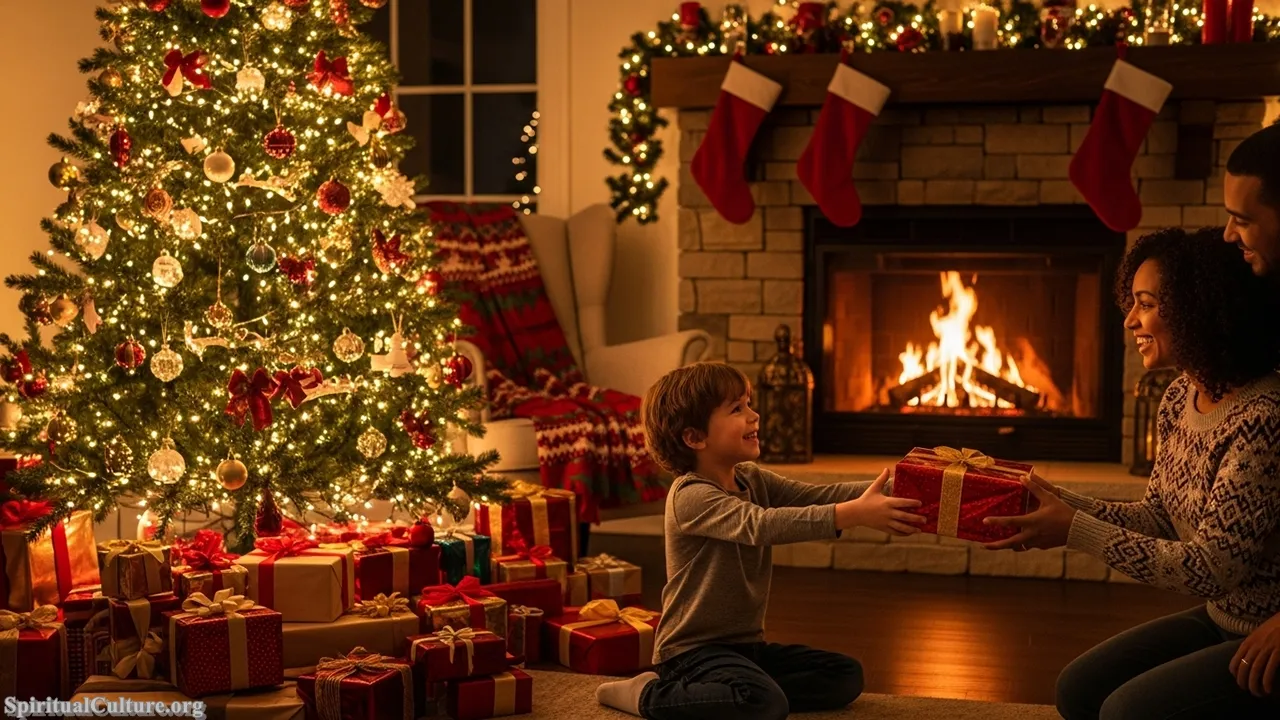
The core spiritual impact is the celebration of generosity, hope, and light during the darkest time of the year. The ritual of giving gifts, often framed through the mythology of Santa Claus, teaches the moral lesson of selfless love and abundance, mirroring the traditional biblical account of the Magi’s gifts. The collective act of decorating homes with lights and trees symbolizes hope and renewal, an ancient spiritual longing for the return of the sun and the coming of brighter times.
The preservation value of the Christmas tradition lies in its power to compel family reunion and mend social rifts. It is a universally understood time for pausing personal ambition and focusing on familial and community bonds, making it a critical time for spiritual and emotional renewal in American society.
Cultural/Spiritual Highlights
- The extensive use of lights and trees symbolizes the spiritual value of hope and life in winter.
- Gift-giving is a central ritual emphasizing generosity, love, and the spirit of abundance.
- The tradition compels family reunion, reinforcing intergenerational spiritual bonds.
- Attracts the highest annual church attendance for many Christian denominations.
Top 2. Independence Day (Fourth of July) Celebrations
Independence Day, commemorating the nation’s declaration of independence in 1776, is the paramount civic and patriotic ritual in the United States. Celebrated by nearly every community in the nation, this tradition involves massive public spectacles of fireworks, parades, and communal barbecues. As a universally recognized federal holiday in November 2025, it serves as the ultimate national affirmation of the country’s founding principles.
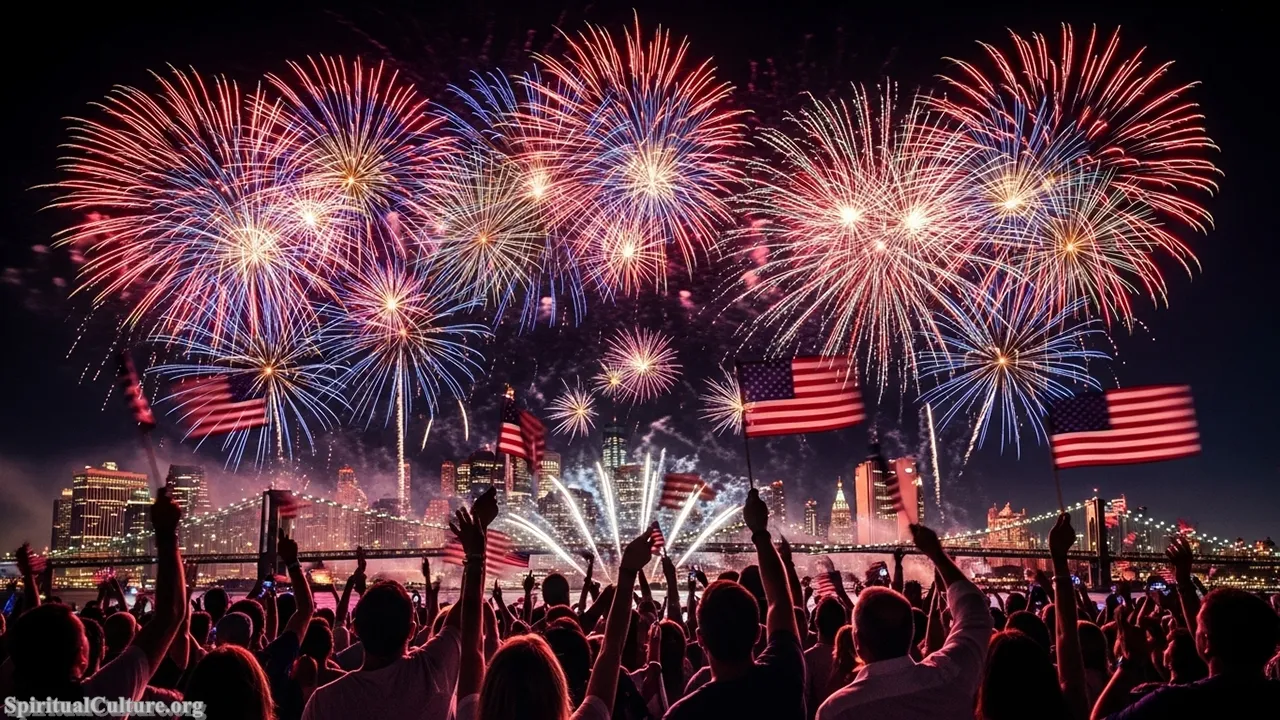
The spiritual impact of the Fourth of July is the affirmation of collective destiny and the sanctity of foundational ideals. The public reading of the Declaration of Independence and the spectacle of fireworks act as a powerful, cathartic annual renewal of the democratic promise. This tradition teaches the moral lesson that freedom is not a passive inheritance but an actively defended right, linking the current generation to the revolutionary generation through a shared symbolic experience of national birth and struggle.
Its preservation value is in maintaining a collective commitment to self-governance. It is a critical spiritual moment where all Americans, regardless of their differences, are invited to share a common identity as citizens of a democratic republic. The visible display of patriotism—flying the flag, wearing red, white, and blue—is a high-impact spiritual exercise in national unity.
Cultural/Spiritual Highlights
- Serves as the highest civic ritual affirming the spiritual value of freedom and democracy.
- Fireworks symbolize the “bombs bursting in air”—a visual link to the nation’s founding struggle.
- Compels collective, localized celebration through parades and community gatherings.
- The national embrace of the American flag is a high-level, annual spiritual-political act.
Top 1. Thanksgiving Feast & Gratitude
The tradition of Thanksgiving, celebrated annually on the fourth Thursday of November, stands as the single most popular and spiritually profound non-denominational American tradition. Its core ritual—a massive family or communal feast centered on themes of gratitude and bounty—is observed by the vast majority of U.S. households. In November 2025, it remains the ultimate expression of the American values of family unity, harvest appreciation, and the practice of thankfulness.
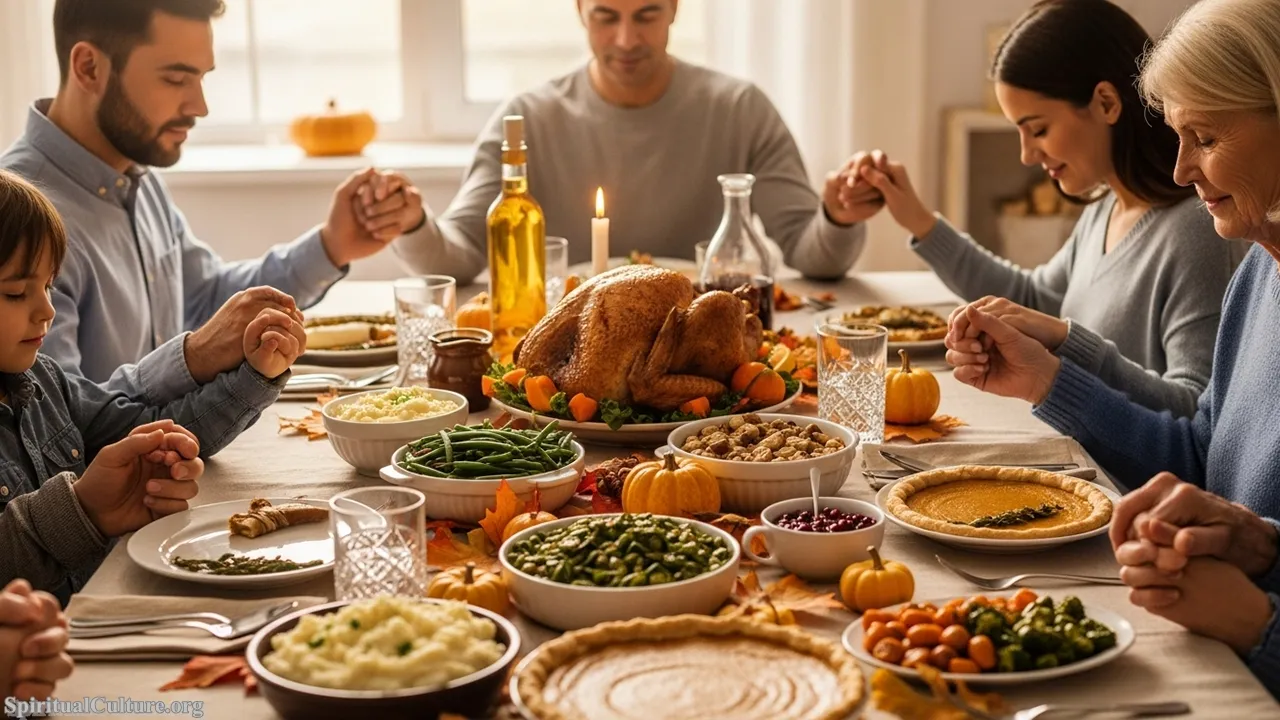
The reason for its number one ranking is its pervasive spiritual imperative: the formal, collective expression of gratitude. The tradition, modeled after the 1621 feast shared between Pilgrims and Wampanoag people, has evolved from a specific religious ceremony to a universally adopted humanistic ritual. It compels people to pause the consumer rush, travel long distances, and reflect on the past year’s blessings, teaching the profound moral lesson that conscious thankfulness is the key to spiritual wealth and emotional stability, irrespective of one’s faith.
The preservation value of Thanksgiving is its role as the nation’s most powerful ritual for family and non-familial reunion. It provides a necessary spiritual pause, forcing the country to shift its focus from acquisition to appreciation. By making gratitude a national collective act, it serves as the essential cultural backbone for American concepts of hospitality, abundance, and fellowship.
Cultural/Spiritual Highlights
- The core ritual is the collective, formal expression of spiritual gratitude and thanks for the harvest.
- The most observed tradition for large-scale family reunion across all demographics.
- The shared turkey feast symbolizes abundance, collective effort, and survival.
- A non-denominational spiritual holiday, unifying diverse peoples under a single moral value.
A Heritage of Hope and Unity
The Top 10 Most Popular American Traditions, as analyzed by Spiritual Culture in November 2025, reveal a culture deeply invested in the dual ideals of individual aspiration and collective unity. From the solemn, grateful reflection of the Thanksgiving table to the joyous, loud affirmation of Independence Day, these rituals are the spiritual scaffolding of the nation. They demonstrate that while America is a country of diverse origins, it finds its profound, unifying spiritual heart in the shared, humanistic values of freedom, hard work, generosity, and, most importantly, the persistent, optimistic pursuit of happiness.
These traditions are not static historical artifacts; they are living, evolving practices that require active participation. They urge every American to look beyond individual difference to find common ground in gratitude and celebration, ensuring that the legacy of hope and democratic spirit is continually renewed for the next generation.


